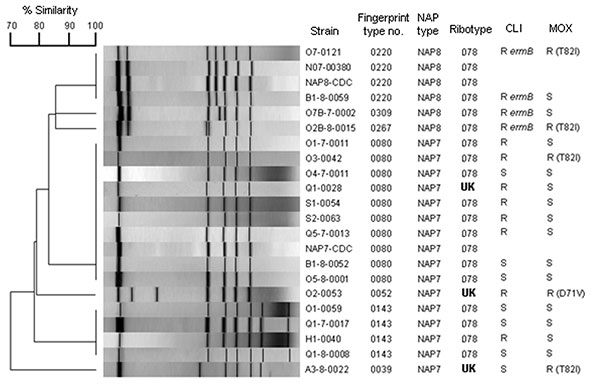Volume 16, Number 4—April 2010
Dispatch
Hypervirulent Clostridium difficile Strains in Hospitalized Patients, Canada1
Figure

Figure. Dendrogram analysis of macrorestriction patterns (SmaI) of the NAP7 and NAP8 Clostridium difficile strains isolated from the patients listed in Table 2. C. difficile N07-00380 is a ribotype 078 control strain. C. difficile NAP7-CDC and NAP8-CDC control strains are toxinotype V. Isolates exhibiting high-level clindamycin resistance (>256 μg/mL) and harboring ermB are indicated. The amino acid change found in the gyrA protein is shown for the moxifloxacin-resistant strain antimicrobial drug–resistance mechanisms.
1Parts of this study were presented at the 48th Interscience Conference on Antimicrobial Agents and Chemotherapy/46th Infectious Disease Society of America meeting in Washington DC, USA, October 25–28, 2008.
2Members of the Canadian Nosocomial Infection Surveillance Program who contributed data are listed at the end of this article.
Members of the Canadian Nosocomial Infection Surveillance Program who participated in the surveillance for C. difficile infection: Elizabeth Bryce, Vancouver General Hospital, Vancouver, British Columbia; John Conly, Foothills Medical Centre, Calgary, Alberta; John Embil, Health Sciences Centre, Winnipeg, Manitoba; Joanne Embree, Health Sciences Centre, Winnipeg; Sarah Forgie, Stollery Children’s Hospital, Edmonton, Alberta; Charles Frenette, McGill University Health Centre, Montreal, Quebec; Camille Lemieux, University Health Network, Toronto, Ontario; Elizabeth Henderson, Peter Lougheed Centre, Calgary; Michael John, London Health Sciences Centre, London, Ontario; Lynn Johnston, QEII Elizabeth Health Sciences Centre, Halifax, Nova Scotia; Pamela Kibsey, Victoria General Hospital, Victoria, British Columbia; Joanne Langley, IWK Health Centre, Halifax; Mark Loeb, Hamilton Health Sciences Corporation, Hamilton, Ontario; Anne Matlow, Hospital for Sick Children, Toronto; Sophie Michaud, CHUS-Hôpital Fleurimont, Sherbrooke, Quebec; Marianne Ofner, Centre for Communicable Diseases and Infection Control, Public Health Agency of Canada, Ottawa, Ontario; Virginia Roth, The Ottawa Hospital, Ottawa; Eva Thomas, Children’s and Women’s Health Center, Vancouver; William Thompson, South East Regional Health Authority, Moncton, New Brunswick; Nathalie Turgeon, Hôtel-Dieu de Québec du CHUQ, Quebec, Quebec; Mary Vearncombe, Sunnybrook Health Sciences Centre, Toronto; Karl Weiss, Maisonneuve-Rosemont Hospital, Montreal; Alice Wong, Royal University Hospital, Saskatoon, Saskatchewan; Dick Zoutman, Kingston General Hospital, Kingston, Ontario.